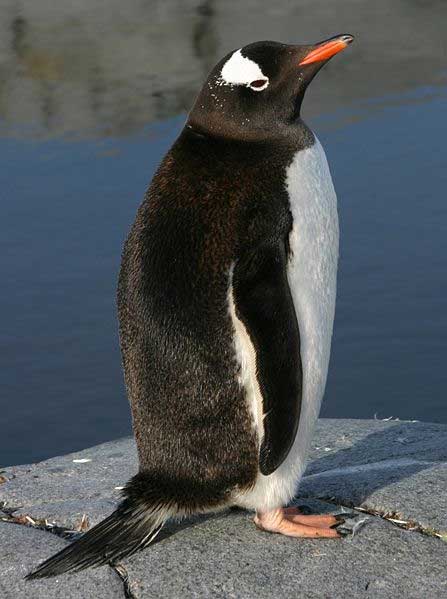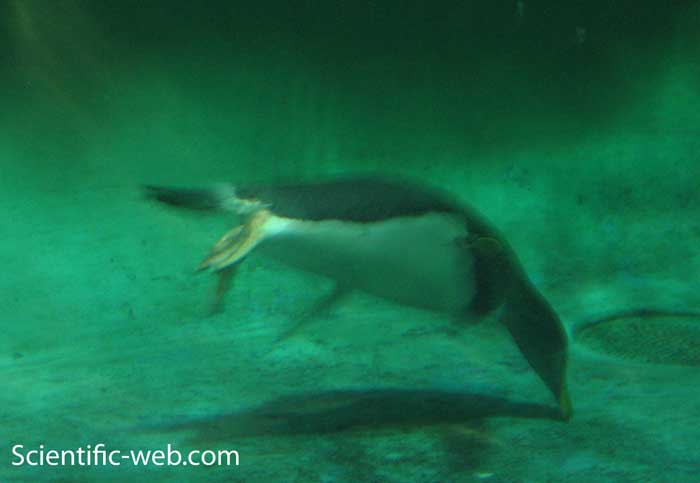Gentoo Penguin
The Gentoo Penguin (pronounced /ˈdʒɛntuː/), Pygoscelis papua, is easily recognized by the wide white stripe extending like a bonnet across the top of its head. Chicks have grey backs with white fronts. Adult Gentoos reach a height of 51 to 90 cm (20-36 in)[1][2], making them the largest penguins outside of the two giant species, the Emperor Penguin and the King Penguin. The application of Gentoo to the penguin is unclear, according to the OED, which reports that Gentoo was an Anglo-Indian term, used as early as 1638 to distinguish Hindus in India from Muslims, the English term originating in Portuguese gentio (compare "gentile"); in the twentieth century the term came to be regarded as derogatory. Taxonomy The Gentoo Penguin is one of three species in the genus Pygoscelis. Mitochondrial and nuclear DNA evidence suggests the genus split from other penguins around 38 million years ago, about 2 million years after the ancestors of the genus Aptenodytes. In turn, the Adelie Penguins split off from the other members of the genus around 19 million years ago, and the Chinstrap and Gentoo finally diverging around 14 million years ago.[3] Two sub-species of this penguin are recognised: Pygoscelis papua papua and the smaller Pygoscelis papua ellsworthii.
Gentoo Penguin, Photo Michael Lahanas Description Males have a maximum weight of about 8.5 kg (18.8 lbs) just before moulting, and a minimum weight of about 4.9 kg (10.8 lbs) just before mating. For females the maximum weight is 8.2 kg (18 lbs) just before moulting, but their weight drops to as little as 4.5 kg (10 lbs) when guarding the chicks in the nest.[4] Birds from the north are on average 700 g (1.5 lbs) and 10 cm (4 in) taller than southern birds.[5] The Gentoo They are the fastest underwater swimming penguins, reaching speeds of 36 km/h. The Gentoo is built for very cold weather environments, unlike its northern cousin the Magellanic Penguin, which is leaner and more mobile in terrestrial movement.[6]
Breeding Gentoos breed on many sub-Antarctic islands. The main colonies are on the Falkland Islands, South Georgia and Kerguelen Islands; smaller populations are found on Macquarie Island, Heard Islands, South Shetland Islands and the Antarctic Peninsula. The total breeding population is estimated to be over 300,000 pairs. Nests are usually made from a roughly circular pile of stones and can be quite large, 20 cm high and 25 cm in diameter. The stones are jealously guarded and their ownership can be the subject of noisy disputes between individual penguins. They are also prized by the females, even to the point that a male penguin can obtain the favors of a female by offering her a nice stone. Two eggs are laid, both weighing around 500 g. The parents share incubation, changing duty daily. The eggs hatch after 34 to 36 days. The chicks remain in the nests for about 30 days before forming creches. The chicks molt into sub-adult plumage and go out to sea at about 80 to 100 days. Diet Gentoos live mainly on crustaceans such as krill, with fish making up only about 15% of the diet. However, they are opportunistic feeders, and around the Falklands are known to take roughly equal proportions of fish (Patagonotothen sp., Thysanopsetta naresi, Micromesistius australis), crustaceans (Munida gregaria) and squid (Loligo gahi, Gonatus antarcticus, Moroteuthis ingens). Threats In the water, sea lions, leopard seals, and orca are all predators of the Gentoo. On land there are no predators of full grown Gentoos, but birds have been known to steal their eggs and chicks. Status Near Threatened (IUCN Red List) References 1. ^ http://animaldiversity.ummz.umich.edu/site/accounts/information/Pygoscelis_papua.html * BirdLife International (2004). Pygoscelis papua. 2006 IUCN Red List of Threatened Species. IUCN 2006. Retrieved on 5 May 2006. Database entry includes a brief justification of why this species is near threatened External links
Retrieved from "http://en.wikipedia.org/" |
|




